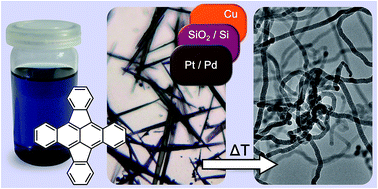Synthesis of carbon nanofibers by thermal conversion of the molecular precursor 5,6;11,12-di-o-phenylenetetracene and its application in a chemiresistive gas sensor†
Abstract
Carbon nanofibers with an amorphous solid structure have been synthesized by thermal conversion of the polycyclic aromatic hydrocarbon 5,6;11,12-di-o-phenylenetetracene (DOPT) at 1000 °C on various substrates. Rapid annealing of DOPT on copper foil, SiO2/Si wafer and a SiO2/Si wafer coated with a 20 nm thick layer of Pt/Pd resulted in growth of carbon nanofibers. The most effective synthesis of these fibers was realized on the latter substrate. The Pt/Pd layer segregates by dewetting under thermal treatment and forms metallic nanoparticles on which dense networks of amorphous carbon nanofibers were prepared and these were successfully applied in chemiresistor gas sensor applications for detection of toxic gases, e.g. nitrogen dioxide, ammonia and sulfur dioxide. Using an analyte concentration of parts per million, the nanofibers show a very good response towards NO2 and SO2, whereas exposure to ammonia resulted only in negligible, minor changes in the electrical resistance of the sensor.



 Please wait while we load your content...
Please wait while we load your content...